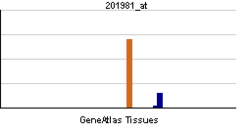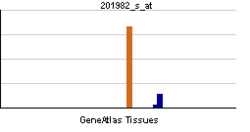- Pregnancy-associated plasma protein A
-
Pregnancy-associated plasma protein A, pappalysin 1 Identifiers Symbols PAPPA; ASBABP2; DIPLA1; IGFBP-4ase; PAPA; PAPP-A; PAPPA1 External IDs OMIM: 176385 MGI: 97479 HomoloGene: 31097 GeneCards: PAPPA Gene EC number 3.4.24.79 Gene Ontology Molecular function • metalloendopeptidase activity
• peptidase activity
• metallopeptidase activity
• metallopeptidase activity
• zinc ion binding
• metal ion bindingCellular component • extracellular region
• extracellular region
• extracellular region
• cytoplasm
• membraneBiological process • female pregnancy
• cell differentiationSources: Amigo / QuickGO RNA expression pattern 

More reference expression data Orthologs Species Human Mouse Entrez 5069 18491 Ensembl ENSG00000182752 ENSMUSG00000028370 UniProt Q13219 Q8R4K8 RefSeq (mRNA) NM_002581.3 NM_021362.1 RefSeq (protein) NP_002572.2 NP_067337.1 Location (UCSC) Chr 9:
118.92 – 119.16 MbChr 4:
64.79 – 65.02 MbPubMed search [1] [2] Pregnancy-associated plasma protein A, pappalysin 1, also known as PAPPA, is a protein used in screening tests for Down syndrome.[1][2]
This gene encodes a secreted metalloproteinase which cleaves insulin-like growth factor binding proteins (IGFBPs). It is thought to be involved in local proliferative processes such as wound healing and bone remodeling. Low plasma level of this protein has been suggested as a biochemical marker for pregnancies with aneuploid fetuses (fetuses with an abnormal number of chromosomes).[2] For example, low PAPPA may be seen in prenatal screening for Down syndrome.[1]
Contents
Interactions
Pregnancy-associated plasma protein A has been shown to interact with Major basic protein.[3][4][5]
References
- ^ a b Breathnach FM, Malone FD (2007). "Screening for aneuploidy in first and second trimesters: is there an optimal paradigm?". Curr. Opin. Obstet. Gynecol. 19 (2): 176–82. doi:10.1097/GCO.0b013e3280895e00. PMID 17353686.
- ^ a b "Entrez Gene: PAPPA pregnancy-associated plasma protein A, pappalysin 1". http://www.ncbi.nlm.nih.gov/sites/entrez?Db=gene&Cmd=ShowDetailView&TermToSearch=5069.
- ^ Overgaard, M T; Haaning J, Boldt H B, Olsen I M, Laursen L S, Christiansen M, Gleich G J, Sottrup-Jensen L, Conover C A, Oxvig C (Oct. 2000). "Expression of recombinant human pregnancy-associated plasma protein-A and identification of the proform of eosinophil major basic protein as its physiological inhibitor". J. Biol. Chem. (UNITED STATES) 275 (40): 31128–33. doi:10.1074/jbc.M001384200. ISSN 0021-9258. PMID 10913121.
- ^ Overgaard, Michael T; Sorensen Esben S, Stachowiak Damian, Boldt Henning B, Kristensen Lene, Sottrup-Jensen Lars, Oxvig Claus (Jan. 2003). "Complex of pregnancy-associated plasma protein-A and the proform of eosinophil major basic protein. Disulfide structure and carbohydrate attachment". J. Biol. Chem. (United States) 278 (4): 2106–17. doi:10.1074/jbc.M208777200. ISSN 0021-9258. PMID 12421832.
- ^ Oxvig, C; Sand O, Kristensen T, Gleich G J, Sottrup-Jensen L (Jun. 1993). "Circulating human pregnancy-associated plasma protein-A is disulfide-bridged to the proform of eosinophil major basic protein". J. Biol. Chem. (UNITED STATES) 268 (17): 12243–6. ISSN 0021-9258. PMID 7685339.
Further reading
- Sinosich MJ, Zakher A (1992). "Pregnancy-associated plasma protein A interaction with heparin: a critical appraisal.". Gynecol. Obstet. Invest. 32 (2): 72–7. doi:10.1159/000292998. PMID 1721035.
- Bischof P, Tseng L (1986). "In vitro release of pregnancy-associated plasma protein-A (PAPP-A) by human endometrial cells.". American journal of reproductive immunology and microbiology : AJRIM 10 (4): 139–42. PMID 2422961.
- Bolton AE, Pinto-Furtado LG, Andrew CE, Chapman MG (1986). "Measurement of the pregnancy-associated proteins, placental protein 14 and pregnancy-associated plasma protein A in human seminal plasma.". Clinical reproduction and fertility 4 (3): 233–40. PMID 2427179.
- Sinosich MJ, Saunders DM (1987). "Potential role of pregnancy-associated plasma protein-A in human reproduction.". J. Reprod. Immunol. 10 (1): 55–65. doi:10.1016/0165-0378(87)90050-7. PMID 2438405.
- Tornehave D, Chemnitz J, Teisner B, et al. (1985). "Immunohistochemical demonstration of pregnancy-associated plasma protein A (PAPP-A) in the syncytiotrophoblast of the normal placenta at different gestational ages.". Placenta 5 (5): 427–31. doi:10.1016/S0143-4004(84)80023-5. PMID 6084247.
- McIntyre JA, Hsi B, Faulk WP, et al. (1982). "Immunological studies of the human placenta: functional and morphological analysis of pregnancy-associated plasma protein A (PAPP-A).". Immunology 44 (3): 577–83. PMC 1554973. PMID 6172371. http://www.pubmedcentral.nih.gov/articlerender.fcgi?tool=pmcentrez&artid=1554973.
- Bischof P, Geinoz A, Herrmann WL, Sizonenko PC (1984). "Pregnancy-associated plasma protein A (PAPP-A) specifically inhibits the third component of human complement (C3).". Placenta 5 (1): 1–7. doi:10.1016/S0143-4004(84)80044-2. PMID 6203109.
- Schindler AM, Bischof P (1984). "Histochemical localization of pregnancy-associated plasma protein A in fetal, infant, and adult organs and comparison between antisera.". Gynecol. Obstet. Invest. 18 (2): 88–94. doi:10.1159/000299055. PMID 6207082.
- Kristensen T, Oxvig C, Sand O, et al. (1994). "Amino acid sequence of human pregnancy-associated plasma protein-A derived from cloned cDNA.". Biochemistry 33 (6): 1592–8. doi:10.1021/bi00172a040. PMID 7508748.
- Durham SK, Kiefer MC, Riggs BL, Conover CA (1994). "Regulation of insulin-like growth factor binding protein 4 by a specific insulin-like growth factor binding protein 4 proteinase in normal human osteoblast-like cells: implications in bone cell physiology.". J. Bone Miner. Res. 9 (1): 111–7. doi:10.1002/jbmr.5650090115. PMID 7512304.
- Bonno M, Oxvig C, Kephart GM, et al. (1994). "Localization of pregnancy-associated plasma protein-A and colocalization of pregnancy-associated plasma protein-A messenger ribonucleic acid and eosinophil granule major basic protein messenger ribonucleic acid in placenta.". Lab. Invest. 71 (4): 560–6. PMID 7526035.
- Oxvig C, Haaning J, Kristensen L, et al. (1995). "Identification of angiotensinogen and complement C3dg as novel proteins binding the proform of eosinophil major basic protein in human pregnancy serum and plasma.". J. Biol. Chem. 270 (23): 13645–51. doi:10.1074/jbc.270.23.13645. PMID 7539791.
- Zorin NA, Zhabin SG, Semenkov NN (1995). "Interaction of human pregnancy-associated plasma protein-A with serine proteinases.". Clin. Chim. Acta 239 (1): 47–55. doi:10.1016/0009-8981(95)06098-X. PMID 7586586.
- Silahtaroglu AN, Tümer Z, Kristensen T, et al. (1993). "Assignment of the human gene for pregnancy-associated plasma protein A (PAPPA) to 9q33.1 by fluorescence in situ hybridization to mitotic and meiotic chromosomes.". Cytogenet. Cell Genet. 62 (4): 214–6. doi:10.1159/000133479. PMID 7679961.
- Oxvig C, Sand O, Kristensen T, et al. (1993). "Circulating human pregnancy-associated plasma protein-A is disulfide-bridged to the proform of eosinophil major basic protein.". J. Biol. Chem. 268 (17): 12243–6. PMID 7685339.
- Haaning J, Oxvig C, Overgaard MT, et al. (1996). "Complete cDNA sequence of the preproform of human pregnancy-associated plasma protein-A. Evidence for expression in the brain and induction by cAMP.". Eur. J. Biochem. 237 (1): 159–63. doi:10.1111/j.1432-1033.1996.0159n.x. PMID 8620868.
- Lawrence JB, Oxvig C, Overgaard MT, et al. (1999). "The insulin-like growth factor (IGF)-dependent IGF binding protein-4 protease secreted by human fibroblasts is pregnancy-associated plasma protein-A.". Proc. Natl. Acad. Sci. U.S.A. 96 (6): 3149–53. doi:10.1073/pnas.96.6.3149. PMC 15910. PMID 10077652. http://www.pubmedcentral.nih.gov/articlerender.fcgi?tool=pmcentrez&artid=15910.
- Overgaard MT, Oxvig C, Christiansen M, et al. (1999). "Messenger ribonucleic acid levels of pregnancy-associated plasma protein-A and the proform of eosinophil major basic protein: expression in human reproductive and nonreproductive tissues.". Biol. Reprod. 61 (4): 1083–9. doi:10.1095/biolreprod61.4.1083. PMID 10491647.
- Overgaard MT, Haaning J, Boldt HB, et al. (2000). "Expression of recombinant human pregnancy-associated plasma protein-A and identification of the proform of eosinophil major basic protein as its physiological inhibitor.". J. Biol. Chem. 275 (40): 31128–33. doi:10.1074/jbc.M001384200. PMID 10913121.
- Hourvitz A, Widger AE, Filho FL, et al. (2001). "Pregnancy-associated plasma protein-A gene expression in human ovaries is restricted to healthy follicles and corpora lutea.". J. Clin. Endocrinol. Metab. 85 (12): 4916–20. doi:10.1210/jc.85.12.4916. PMID 11134163.
External links
ADAM proteins Matrix metalloproteinases Other Neprilysin · Procollagen peptidase · Thermolysin · Pregnancy-associated plasma protein A · Bone morphogenetic protein 1 · Lysostaphin · Insulin degrading enzyme · ZMPSTE24B enzm: 1.1/2/3/4/5/6/7/8/10/11/13/14/15-18, 2.1/2/3/4/5/6/7/8, 2.7.10, 2.7.11-12, 3.1/2/3/4/5/6/7, 3.1.3.48, 3.4.21/22/23/24, 4.1/2/3/4/5/6, 5.1/2/3/4/99, 6.1-3/4/5-6 Categories:- Human proteins
- Biochemistry stubs
Wikimedia Foundation. 2010.
